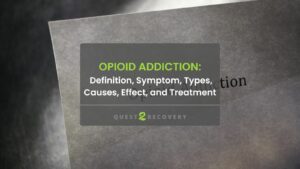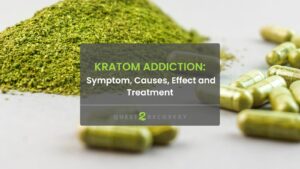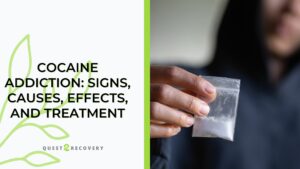Kratom addiction refers to the compulsive use of Kratom, a tropical tree native to Southeast Asia. Kratom leaves contain psychoactive compounds that interact with opioid receptors in the brain, producing effects similar to opioids such as pain relief, sedation, and euphoria.
The symptoms of kratom addiction typically include increased tolerance, withdrawal symptoms upon cessation, intense cravings for the substance, social and occupational impairment, and physical health issues.
The causes of kratom addiction are multifaceted and involve biological, psychological, and environmental factors.
Kratom addiction has a range of effects on individuals, including physical health declines such as gastrointestinal issues, liver damage, respiratory problems, and cardiovascular complications.
The treatment of kratom addiction typically includes medical detoxification, behavioral therapies, support groups, medication-assisted treatment, and holistic approaches to address the physical, psychological, and social aspects of addiction.
What Is Kratom Addiction?
Kratom addiction refers to the condition where individuals develop a dependence on Kratom, a psychoactive substance derived from the leaves of a tree native to Southeast Asia.
Kratom, scientifically known as Mitragyna speciosa, is a tropical tree native to Southeast Asia. The leaves of the Kratom tree contain psychoactive compounds, primarily mitragynine and 7-hydroxymitragynine, which interact with opioid receptors in the brain, producing effects similar to opioids such as pain relief, sedation, and euphoria.
However, kratom’s unique pharmacological profile, including its partial opioid agonist properties and interactions with other neurotransmitter systems, contributes to distinct patterns of addiction and withdrawal.
People take kratom for several reasons, including mood elevation, pain relief, increased energy, and alleviating opioid withdrawal symptoms. Kratom interacts with the same opioid receptors as drugs like morphine to relieve withdrawal discomfort and cravings, similar to methadone treatment. Nevertheless, for safety reasons, professional treatment needs to be sought for opioid withdrawal rather than self-medicating with kratom.
Kratom has not been FDA-approved for any medical purpose. While it helps minimize the symptoms of these conditions, it also exposes users to potential dangers, including hallucinations, psychosis, respiratory depression, seizures, heart problems, liver damage, addiction, overdose, and death.
What Are the Symptoms of Kratom Addiction?
Symptoms of kratom addiction manifest in various ways, affecting physical, psychological, and social aspects of an individual’s life. Here’s a comprehensive list of symptoms associated with Kratom addiction:
Increased Tolerance: Over time, individuals need higher doses of Kratom to achieve the desired effects due to the development of tolerance.
Withdrawal Symptoms: Abrupt cessation of Kratom leads to a range of withdrawal symptoms, including:
- Irritability
- Nausea and vomiting
- Muscle aches and joint pain
- Restlessness and agitation
- Anxiety and panic attacks
- Insomnia or disturbed sleep patterns
- Sweating and chills
- Hot flashes
Cravings: Individuals with kratom addiction often experience intense cravings for the substance, leading to compulsive use despite negative consequences.
Physical Health Issues: Prolonged kratom abuse results in various physical health problems, such as:
- Gastrointestinal issues (constipation, stomach cramps)
- Weight loss or fluctuations in appetite
- Liver damage or abnormalities in liver function tests
- Respiratory issues (difficulty breathing, chest discomfort)
- Cardiovascular complications (elevated heart rate, high blood pressure)
Psychological Effects: Kratom addiction also impacts mental health and cognition, leading to:
- Mood swings and emotional instability
- Anxiety disorders and panic attacks
- Depression or worsening of existing depressive symptoms
- Cognitive impairment and difficulty concentrating or remembering
- Impaired decision-making abilities and judgment
Social and Occupational Impairment: Kratom addiction interferes with social relationships, work performance, and daily responsibilities, resulting in:
- Neglect of family or social obligations
- Strained relationships with friends, family, or colleagues
- Difficulties maintaining employment or academic performance
- Financial problems due to excessive spending on Kratom
Isolation and Avoidance: Individuals with Kratom addiction withdraw from social activities, hobbies, or interests they previously enjoyed, preferring to spend time using Kratom instead.
Denial and Defensiveness: Some individuals exhibit denial or defensiveness about their Kratom use, minimizing the severity of their addiction or becoming defensive when confronted about their behavior.
These symptoms vary in intensity depending on factors such as the duration of Kratom use, dosage, individual physiology, and co-occurring mental health conditions.
What Are the Causes of Kratom Addiction?
A combination of biological, psychological, and environmental factors influences the causes of kratom addiction. Here are the key factors contributing to Kratom addiction:
- Biological Factors: Genetic predisposition and individual differences in brain chemistry play a role in addiction susceptibility. Some individuals have a higher propensity for developing addiction due to genetic factors that affect neurotransmitter function and reward pathways in the brain.
- Neurochemical Effects: Kratom contains alkaloids such as mitragynine and 7-hydroxymitragynine, which interact with opioid receptors in the brain. These interactions produce pleasurable effects, leading to the potential for dependence and addiction over time.
- Psychological Factors: Psychological factors such as stress, trauma, anxiety, or depression contribute to kratom addiction. Individuals use kratom as a coping mechanism to alleviate emotional distress or escape from negative feelings, leading to psychological dependence.
- Social and Environmental Influences: Social factors, including peer pressure, social acceptance of kratom use, and easy accessibility of kratom products, influence addictive behaviors. Exposure to environments where kratom use is normalized or encouraged increases the likelihood of developing addiction.
- Co-occurring Mental Health Disorders: People with underlying mental health conditions, such as anxiety disorders, depression, post-traumatic stress disorder (PTSD), or chronic pain, turn to kratom as a self-medication strategy. This creates a cycle of dependence and addiction as individuals rely on kratom to manage their symptoms.
- Trauma and Adverse Life Events: Experiencing trauma, abuse, or significant life stressors present substance use disorders, including kratom addiction. Traumatic experiences drive individuals to seek relief or numbness through substance use, leading to addiction as a maladaptive coping mechanism.
- Reinforcement and Conditioning: The pleasurable effects of Kratom, such as euphoria, relaxation, and pain relief, reinforce addictive behaviors. Positive reinforcement from these effects precipitates repeated use and the development of addiction patterns.
- Early Exposure and Use: Early exposure to substance use, including Kratom, during adolescence or young adulthood, augments the risk of addiction later in life. Early initiation of substance use alters brain development and accelerates vulnerability to addiction.
What Are the Effects of Kratom Addiction?
Kratom addiction has a smorgasbord of effects on an individual’s physical health, mental well-being, social interactions, and overall quality of life. Here are the effects commonly associated with Kratom addiction:
Physical Health Effects of Kratom Addiction:
Prolonged Kratom abuse has various physical health issues, including:
- Gastrointestinal problems such as constipation, stomach cramps, and nausea
- Weight loss or fluctuations in appetite
- Liver damage or abnormalities in liver function tests
- Respiratory issues such as difficulty breathing or chest discomfort
- Cardiovascular complications like elevated heart rate or high blood pressure
Psychological Effects of Kratom Addiction:
Kratom addiction impact mental health and cognitive functioning, resulting in:
- Mood swings, irritability, and emotional instability
- Anxiety disorders, panic attacks, and heightened anxiety levels
- Depression or worsening of existing depressive symptoms
- Cognitive impairment, including difficulties with concentration, memory, and decision-making
- Psychosis or hallucinations in severe cases or with high doses
Social and Relationship Effects of Kratom Addiction:
Addiction to Kratom strains relationships and breeds social isolation due to:
- Neglect of family, social, or occupational responsibilities
- Conflict and tension within relationships, including strained interactions with friends and family members
- Isolation and withdrawal from social activities or hobbies
Financial Challenges: Excessive spending on Kratom to support addiction sparks financial strain, debt, and difficulties managing finances effectively.
Legal and Behavioral Risks: Kratom addiction also poses legal risks if individuals engage in risky behaviors to obtain or use Kratom, such as purchasing from unregulated sources or driving under the influence.
Physical Dependence and Withdrawal: With chronic use, individuals develop physical dependence on Kratom, leading to withdrawal symptoms upon cessation or reduction in use. These withdrawal symptoms are uncomfortable and include:
- Irritability, agitation, and mood swings
- Muscle aches, joint pain, and restlessness
- Nausea, vomiting, and diarrhea
- Insomnia or disturbed sleep patterns
- Sweating, chills, and flu-like symptoms
Impaired Functioning: Kratom addiction impairs daily functioning in various life domains, including work, school, and personal relationships, leading to difficulties in maintaining productivity, meeting obligations, and achieving goals.
The severity and specific effects of Kratom addiction depend on factors such as individual physiology, dosage, duration of use, co-occurring mental health conditions, and social support networks.
What Is the Treatment of Kratom Addiction?
Treating Kratom addiction comprises a collective approach that addresses physical dependence, psychological factors, and behavioral patterns associated with addiction. Here are the main treatments used for Kratom addiction:
Medical Detoxification: Supervised medical detoxification is often the first step in treating kratom addiction. Medical professionals monitor withdrawal symptoms and provide medications or supportive care to manage discomfort and ensure safety during the detox process.
Behavioral Therapies: Behavioral therapies are essential components of addiction treatment. Therapeutic approaches such as cognitive-behavioral therapy (CBT), dialectical behavior therapy (DBT), and motivational interviewing (MI) help individuals:
- Identify and change addictive behaviors and thought patterns
- Develop coping skills to manage cravings, stress, and triggers
- Address underlying issues contributing to addiction, such as trauma or co-occurring mental health disorders
Support Groups: Participating in support groups such as Narcotics Anonymous (NA), Kratom Anonymous (KA), or other peer support programs provides valuable peer support, encouragement, and accountability during recovery. These groups offer a sense of community, shared experiences, and practical strategies for maintaining sobriety.
Medication-Assisted Treatment (MAT): In some cases, medications are used as part of a comprehensive treatment plan for Kratom addiction. Medications such as buprenorphine, naltrexone, or clonidine help reduce cravings, manage withdrawal symptoms, and support long-term recovery. Nonetheless, the use of medications in Kratom addiction treatment is carefully considered and monitored by healthcare professionals.
Holistic Approaches: Holistic therapies and complementary interventions enhance overall well-being and support addiction recovery. These include:
- Mindfulness-based practices such as meditation, yoga, and deep breathing exercises
- Nutrition counseling and dietary changes to support physical health and recovery
- Exercise programs and physical activities to promote mental and physical wellness
- Stress-reduction techniques, relaxation strategies, and creative therapies
Education and Relapse Prevention: Education about kratom addiction, its effects, and strategies for relapse prevention is crucial for individuals in recovery. Learning about triggers, coping mechanisms, and healthy lifestyle habits, and developing a relapse prevention plan support individuals to maintain sobriety and navigate challenges in the long term.
Family and Social Support: Involving family members, loved ones, and supportive social networks in the recovery process ameliorates outcomes and grants additional sources of encouragement, understanding, and accountability.
Are there natural alternatives to Kratom for pain management and mood enhancement?
Yes, several natural alternatives exist for pain management and mood enhancement, such as herbal supplements, mindfulness practices, physical exercise, and lifestyle modifications. Consulting healthcare providers to explore safe and effective alternatives.
What are the early signs of Kratom addiction?
Early signs of Kratom addiction include a noticeable increase in usage and dependence on the substance to function normally throughout the day. Users may start consuming Kratom more frequently or in higher doses than intended. Other early signs can include preoccupation with obtaining and using Kratom, neglect of social and professional responsibilities, and experiencing withdrawal symptoms such as irritability, mood swings, and physical discomfort when not using the substance.
How does Kratom addiction impact mental health?
Kratom addiction can have significant effects on mental health. Users may experience increased anxiety, depression, or mood swings as a result of regular Kratom use. The substance can alter brain chemistry, leading to dependency and affecting the natural balance of neurotransmitters, which can exacerbate existing mental health issues or trigger new ones. Additionally, the stress of managing an addiction can contribute to emotional distress and social isolation, further impacting an individual’s mental health.
How do withdrawal symptoms of Kratom compare to those of marijuana?
Withdrawal symptoms from Kratom and marijuana can vary significantly due to the substances’ different effects on the brain and body. Kratom withdrawal symptoms are often more physically intense, reflecting its interaction with opioid receptors. These can include muscle aches, insomnia, irritability, aggression, emotional changes, runny nose, and sweating. In contrast, marijuana withdrawal symptoms tend to be less severe and more psychological in nature, including mood swings, cravings, restlessness, sleep difficulties, and in some cases, depression.
How is Kratom addiction treatment different from opioid addiction treatment?
While Kratom and opioids act on similar brain receptors, treatment approaches can differ due to Kratom’s unique properties and legal status in various regions. Kratom addiction treatment may focus more on behavioral therapies and support groups rather than the medication-assisted treatments commonly used for opioid addiction, like methadone or buprenorphine. However, some principles of addiction treatment, such as cognitive-behavioral therapy and relapse prevention strategies, are similar for both.
What are the legal implications of using Kratom?
Kratom’s legal status changes by country and region. Some places have banned or restricted its use, while others allow it for medicinal or recreational purposes. Understanding local laws and regulations is crucial to avoid legal issues related to Kratom use.









